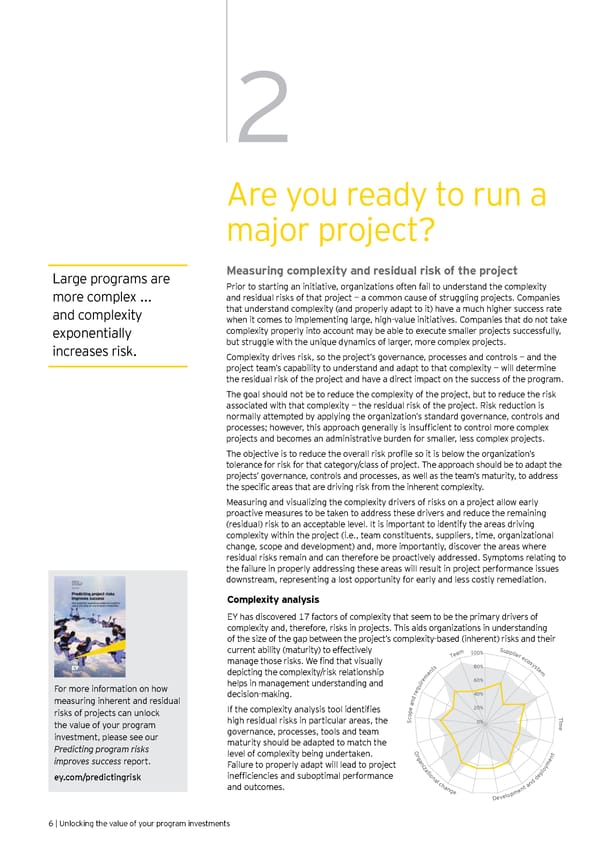2 Are you ready to run a major project? Large programs are Measuring complexity and residual risk of the project Prior to starting an initiative, organizations often fail to understand the complexity more complex ... and residual risks of that project — a common cause of struggling projects. Companies and complexity that understand complexity (and properly adapt to it) have a much higher success rate when it comes to implementing large, high-value initiatives. Companies that do not take exponentially complexity properly into account may be able to execute smaller projects successfully, increases risk. but struggle with the unique dynamics of larger, more complex projects. Complexity drives risk, so the project’s governance, processes and controls — and the project team’s capability to understand and adapt to that complexity — will determine the residual risk of the project and have a direct impact on the success of the program. The goal should not be to reduce the complexity of the project, but to reduce the risk associated with that complexity — the residual risk of the project. Risk reduction is normally attempted by applying the organization’s standard governance, controls and processes; however, this approach generally is insufficient to control more complex projects and becomes an administrative burden for smaller, less complex projects. The objective is to reduce the overall risk profile so it is below the organization’s tolerance for risk for that category/class of project. The approach should be to adapt the projects’ governance, controls and processes, as well as the team’s maturity, to address the specific areas that are driving risk from the inherent complexity. Measuring and visualizing the complexity drivers of risks on a project allow early proactive measures to be taken to address these drivers and reduce the remaining (residual) risk to an acceptable level. It is important to identify the areas driving complexity within the project (i.e., team constituents, suppliers, time, organizational change, scope and development) and, more importantly, discover the areas where residual risks remain and can therefore be proactively addressed. Symptoms relating to the failure in properly addressing these areas will result in project performance issues downstream, representing a lost opportunity for early and less costly remediation. Complexity analysis EY has discovered 17 factors of complexity that seem to be the primary drivers of complexity and, therefore, risks in projects. This aids organizations in understanding of the size of the gap between the project’s complexity-based (inherent) risks and their S current ability (maturity) to effectively u p m 100% p a l i e e T r e c o manage those risks. We find that visually s y s 80% t s e t m n depicting the complexity/risk relationship e m 60% e r helps in management understanding and i u For more information on how q e 40% r decision-making. d measuring inherent and residual n a 20% If the complexity analysis tool identifies e risks of projects can unlock p o T c high residual risks in particular areas, the S 0% i m the value of your program governance, processes, tools and team e investment, please see our maturity should be adapted to match the Predicting program risks level of complexity being undertaken. Or t improves success report. Failure to properly adapt will lead to project gani men za y t lo ey.com/predictingrisk inefficiencies and suboptimal performance iona dep l d ch an a and outcomes. nge ent elopm v De 6 | Unlocking the value of your program investments
 Unlocking the Value of your Program Investments Page 7 Page 9
Unlocking the Value of your Program Investments Page 7 Page 9